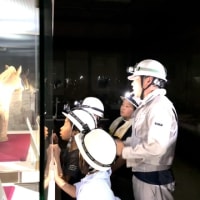Hi, there!
We wrote about the universal value of the pictorial records of coal mines in the “Sakubei Yamamoto Collection” as “visual and specific records by a former pit worker who experienced mining underground” in our last blog titled ‘Valuableness of Sakubei Yamamoto Collection.’ We would like to investigate their appeal further this time.
The “Sakubei Yamamoto Collection” is introduced in the website of UNESCO Memory of the World as follows:

”The collection of annotated paintings and diaries of Sakubei Yamamoto is a personal testimony to the developments during the late Meiji era and into the later twentieth century, when the industrial revolution was still being acted out in the coal mining industry of Chikuho.
The collection combines naive art with text, informed by diaries written during the events being depicted, painted by a man who lived through the events and worked literally at the coal-face.
It is highly unusual in a Japanese context as a private record created by a working man, whereas the dominant records of the period are official government and business papers.
The Sakubei paintings have a rawness and immediacy that is totally missing from the official record, and the collection is a totally authentic personal view of a period of great historical significance to the world”
The great significance of the “Sakubei Yamamoto Collection” lies in the fact that it is recorded by a person who lived through the main part of the history of Japanese coal mining as a pit worker in the Chikuho Coal Field which played the most important role in the progress of ‘Japanese industrial revolution’ and modernization. The worldwide importance of the above progress is represented by “Sites of Japan’s Meiji Industrial Revolution: Iron and Steel, Shipbuilding and Coal Mining,” which were registered onto the UNESCO World Heritage List in July, 2015.
This collection was also highly prized because it accords with the criterion in the General Guidelines that goes: ‘It charts the evolution of thought, discovery and achievement of human society.’
Additionally, the collection is regarded as “memory shared by a group of people” who were nameless and supported modernization by engaging in coal mining as well as personal memory.
We can find, in the “Sakubei Yamamoto Collection,” the same significance as what we find in “Diaries of Anne Frank (Netherlands),” which were also inscribed onto the Memory of the World Register as not only personal diaries of a young girl but also “collective memory” shared by those who were persecuted.
We are going to introduce the detailed contents of Sakubei paintings in the collection next time.


























※コメント投稿者のブログIDはブログ作成者のみに通知されます